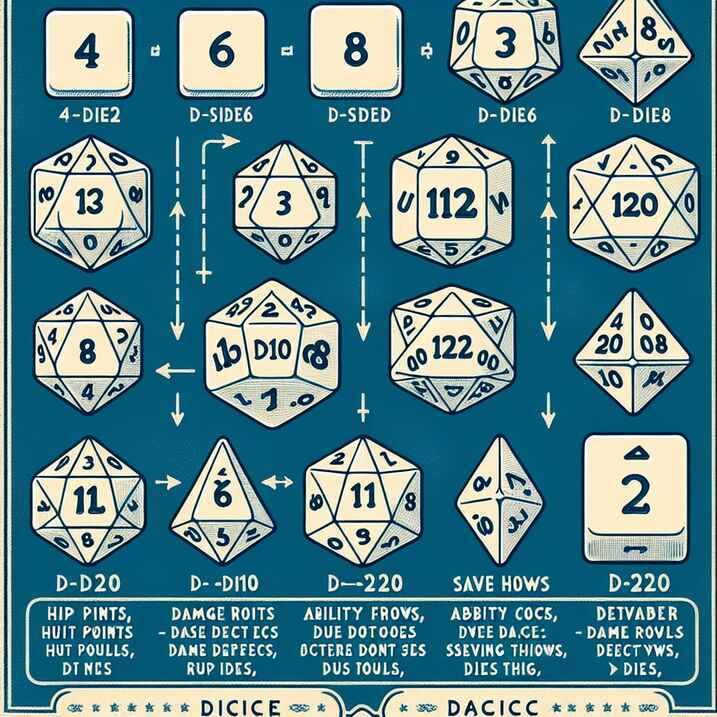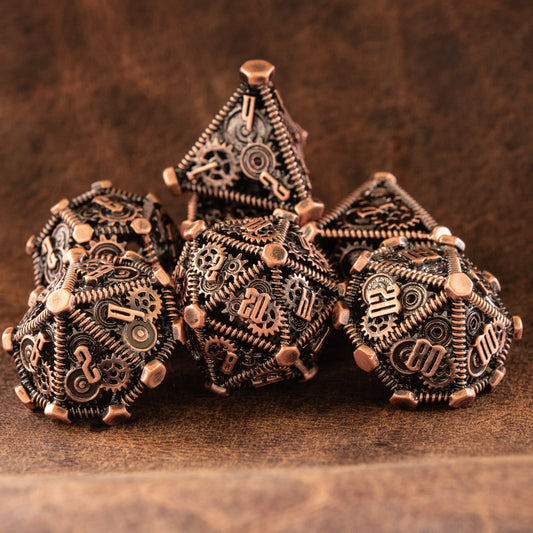
Understanding What Each DND Dice is For: A Comprehensive Guide
Share
Understanding What Each DND Dice is For: A Comprehensive Guide
Introduction
Ever wondered what each uniquely shaped DND dice is for? Dive into our comprehensive guide to unlock the mysteries behind these polyhedral wonders. This article explores the various types of DND dice, their specific purposes, and how they enhance your gameplay experience.
Understanding the Basics
The Role of Dice in Dungeons & Dragons
Importance of Dice in Gameplay
In the realm of Dungeons & Dragons (DND), dice are more than just tools; they are the very essence of the game's mechanics. Each roll determines the fate of your character's actions, from the success of a daring leap over a chasm to the damage inflicted by a spell. The randomness introduced by these dice ensures that every game session is unpredictable and thrilling.
Overview of a Standard Dice Set
A standard DND dice set includes seven polyhedral dice, each with a specific role:
- D4 (Four-Sided Dice)
- D6 (Six-Sided Dice)
- D8 (Eight-Sided Dice)
- D10 (Ten-Sided Dice)
- D12 (Twelve-Sided Dice)
- D20 (Twenty-Sided Dice)
- D100 (Percentile Dice)
Detailed Breakdown of Each Dice
D4 - Four-Sided Dice
The D4, often resembling a small pyramid, is typically used for:
- Small weapon damage, such as daggers.
- Healing spells, providing a modest amount of recovery.
D6 - Six-Sided Dice
The D6 is a familiar cube-shaped die, commonly used for:
- Determining damage from spells like Fireball.
- Weapon damage, especially for simpler weapons.
D8 - Eight-Sided Dice
The D8, with its octahedral shape, is crucial for:
- Calculating moderate damage values.
- Hit dice for classes like Clerics.
Applications in Gameplay
Combat Scenarios
Using D4 for Small Weapons
In the heat of battle, the D4 often comes into play when dealing with small weapons. For example, a rogue's dagger might deal 1d4 damage, making it perfect for quick, precise strikes.
D6 in Spell Damage Calculation
The D6 is indispensable in spellcasting. Wizards and sorcerers frequently roll D6s to determine the damage of spells like Magic Missile or Fireball, adding a layer of excitement and unpredictability to magical combat.
D8 for Moderate Weapon Damage
Moderate weapons, such as longswords or battleaxes, often use the D8. This die strikes a balance between the smaller D4 and the more powerful D10 or D12, making it a versatile choice for many classes.
Non-Combat Uses
Healing and Buff Spells with D4
Outside of combat, the D4 shines in healing and buff spells. Clerics may use it to cast Cure Wounds, restoring a small but vital amount of health to their allies.
Skill Checks and Ability Rolls with D6 and D8
Skill checks and ability rolls frequently utilize the D6 and D8. Whether you're attempting to pick a lock (Dexterity check) or decipher ancient runes (Intelligence check), these dice help determine your success.
By understanding the specific uses of each DND dice, players can enhance their gameplay experience, making every roll count. Whether in combat or during skillful maneuvers, these polyhedral wonders are integral to the world of Dungeons & Dragons.
Understanding What Each DND Dice is For: A Comprehensive Guide
Advanced Dice Mechanics
Understanding Higher-Sided Dice
D10 - Ten-Sided Dice
The D10, a decahedron with values ranging from 1 to 10, is pivotal in determining higher damage values and specific spell effects. It often comes into play with powerful spells like Eldritch Blast or for calculating the damage of weapons such as heavy crossbows. Paladins and fighters frequently rely on the D10 for their hit dice, making it a staple for characters who deal significant damage or absorb considerable hits.
D12 - Twelve-Sided Dice
The D12, a dodecahedron, is reserved for the most potent weaponry and spells. Barbarians, with their immense strength and resilience, use the D12 for their hit dice, reflecting their capacity to endure and inflict severe damage. Weapons like the greataxe or spells such as Cone of Cold leverage the D12, making it a symbol of raw power in the DND universe.
D20 - Twenty-Sided Dice
The D20 is the cornerstone of the DND system, omnipresent in almost every action check, from attack rolls to saving throws. This iconic die, with values from 1 to 20, determines the success or failure of most actions. Rolling a natural 20 often signifies a critical success, while a natural 1 can spell disaster. The D20's versatility and importance cannot be overstated, as it governs the very fate of your character's journey.
D100 - Percentile Dice
The D100, or percentile dice, introduces a layer of probability and randomness to the game. Comprised of two D10s, one representing tens and the other units, it is used for events with a percentage-based outcome. Whether determining the likelihood of finding a rare item or the success rate of a complex maneuver, the D100 adds depth and unpredictability to the gameplay.
Special Dice Rolls
Attack Rolls and Damage Calculation
In combat, attack rolls are made using the D20 to determine if an attack hits the target. Once a hit is confirmed, damage calculation comes into play, utilizing various dice depending on the weapon or spell. For instance, a longsword might require a D8, while a fireball spell could involve multiple D6s. This multi-dice system ensures that each attack is unique and thrilling.
Skill Checks and Saving Throws
Skill checks and saving throws also rely heavily on the D20. When a character attempts an action that requires skill, such as climbing a wall or deceiving a guard, a skill check is made. Similarly, saving throws are rolled to resist effects like poison or magical spells. The outcome, influenced by the character’s abilities and modifiers, adds a strategic layer to decision-making.
Percentile Rolls for Random Events
Percentile rolls, using the D100, are often reserved for determining the outcome of random events. Dungeon Masters (DMs) might use these rolls to decide the contents of a treasure chest, the chances of encountering a wandering monster, or the success of a rare crafting attempt. This mechanism ensures that the game remains dynamic and filled with surprises.
Enhancing Your Gameplay with Dice
Choosing the Right Dice Set
Factors to Consider
Selecting the right dice set involves considering factors such as material, weight, and readability. Plastic dice are durable and affordable, while metal dice offer a satisfying heft. Additionally, the design and color scheme can reflect your character’s aesthetic, enhancing the immersive experience.
Popular Dice Brands
Several brands stand out for their quality and variety. Chessex is renowned for its extensive range and durability, while Wiz Dice offers affordable bulk sets. Easy Roller Dice Company provides premium options, including metal dice, and Kraken Dice is known for its unique, vibrant designs. Choosing a reputable brand ensures consistency and longevity in your dice collection.
Caring for Your Dice
Proper Storage Solutions
Storing your dice properly is crucial for maintaining their condition. Dice bags, often made of cloth or leather, provide a soft, protective environment. For larger collections, compartmentalized trays or display cases can keep your dice organized and easily accessible.
Maintenance Tips
Regularly cleaning your dice with a soft cloth can prevent buildup of dirt and oils. Avoid rolling dice on hard surfaces to prevent chipping or scratching—dice trays offer a cushioned alternative. Inspect your dice periodically for damage and replace any that show significant wear to ensure fair rolls.
Advanced Tips for Dice Rolling
Using Dice Trays and Towers
Dice trays and towers not only protect your dice but also enhance the rolling experience. Trays provide a contained space, preventing dice from scattering, while towers add an element of fun and randomness, ensuring fair rolls.
Improving Roll Accuracy
To improve roll accuracy, practice consistent rolling techniques. Holding the dice with a relaxed grip and rolling them with a smooth motion can result in more predictable outcomes. Additionally, using a flat, even surface can minimize bias in rolls.
Understanding the intricacies of each DND dice and their applications can significantly enhance your gameplay experience. From the foundational D20 to the specialized D100, each die has a unique role in shaping the narrative and outcomes of your adventures. By choosing the right dice set, caring for your dice, and mastering rolling techniques, you can elevate your DND sessions to new heights.
Call to Action
Share this guide with your fellow adventurers and explore our related content to deepen your understanding of DND gameplay. Equip yourself with the right dice and embark on epic quests with confidence and excitement.
By mastering the art of dice in Dungeons & Dragons, you unlock the full potential of your character’s journey, making every roll an opportunity for legendary tales and unforgettable moments.


